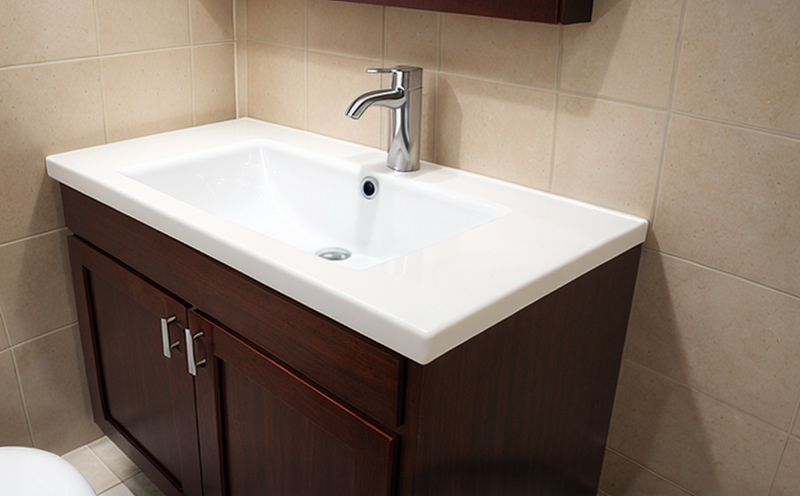ASTM D543 Resistance to Household Chemicals Testing of Sanitary Plastics
The ASTM D543 standard is a critical method used in the quality control and development phases of sanitary plastic products. This testing ensures that materials used in bathroom fixtures, such as sinks, toilets, and shower trays, can withstand exposure to common household chemicals without degrading or deteriorating over time. The test evaluates how well these plastics maintain their integrity when exposed to various chemical substances found in everyday use.
The process involves submerging the specimen of sanitary plastic into a solution that simulates real-world conditions. This solution typically includes water, acetic acid, sodium hydroxide, and ethylene glycol. The test is conducted at room temperature for 24 hours to ensure that any changes in properties can be observed within a reasonable time frame.
After the exposure period, the specimen is thoroughly dried and inspected for any signs of degradation such as discoloration, loss of gloss, or physical damage like cracking. The test also measures the tensile strength and elongation at break before and after the chemical exposure to assess if there has been a significant change in material properties.
This testing procedure is essential for manufacturers aiming to ensure their products meet industry standards and consumer expectations regarding longevity and safety. By adhering to ASTM D543, companies can demonstrate that their sanitary plastics are durable and reliable under real-world conditions.
- Customer Impact: Ensures product longevity, enhancing customer satisfaction by guaranteeing durability.
- Safety Assurance: Reduces the risk of material failure leading to potential health hazards or hygiene issues in bathroom environments.
- Market Competitiveness: Provides a competitive edge through consistent quality and adherence to industry benchmarks.
The ASTM D543 test is particularly important for R&D engineers who are developing new materials or improving existing ones. Compliance officers can use this testing as part of their quality assurance process, ensuring that all products meet regulatory requirements before release to the market.
For procurement teams, this standard serves as a specification guide when selecting suppliers and materials for bathroom fixtures. By specifying ASTM D543 compliance in contracts, they ensure that only high-quality materials are used, contributing to the overall performance and reliability of end products.
Benefits
The primary benefit of conducting ASTM D543 testing lies in its ability to provide a comprehensive evaluation of sanitary plastic materials under realistic conditions. This ensures that manufacturers can deliver products that are not only aesthetically pleasing but also functional and long-lasting.
By ensuring compliance with this standard, businesses can:
- Enhance Product Quality: By identifying potential weaknesses in material performance early in the development process.
- Achieve Regulatory Compliance: Meeting regulatory standards is crucial for market entry and maintaining a positive brand reputation.
- Promote Consumer Trust: Consumers are more likely to trust products that have undergone rigorous testing, leading to increased sales and customer loyalty.
- Reduce Liability Risks: Ensuring product safety can help protect companies from legal action due to product failures or harmful chemical releases.
In summary, ASTM D543 testing is a vital part of the quality assurance process for sanitary plastics. It helps manufacturers produce reliable products that meet market demands and regulatory requirements while enhancing overall customer satisfaction and trust.
Customer Impact and Satisfaction
Conducting ASTM D543 resistance to household chemicals testing directly impacts customer satisfaction by ensuring that sanitary plastics used in bathroom fixtures are durable and reliable. This not only enhances the longevity of products but also improves user experience, leading to higher levels of customer trust and loyalty.
- Durability: Products that pass ASTM D543 testing are less likely to degrade over time, ensuring consistent performance in harsh household environments.
- Safety: By meeting the standards set by ASTM D543, manufacturers can ensure that their products do not release harmful chemicals into the environment or pose risks to users.
- Eco-Friendly: The durability and longevity of materials tested under ASTM D543 contribute positively to environmental sustainability efforts. This reduces waste generation and promotes resource-efficient practices.
The test results are not only valuable for manufacturers but also provide transparency to customers, who can be assured that the products they purchase meet strict quality and safety standards.
In summary, ASTM D543 testing plays a crucial role in enhancing customer satisfaction by delivering reliable, safe, and environmentally friendly sanitary plastic materials. This contributes significantly to the overall success of businesses operating within this sector.
Environmental and Sustainability Contributions
The ASTM D543 resistance to household chemicals testing is not only beneficial for product quality but also has significant positive impacts on environmental sustainability. By ensuring that sanitary plastics used in bathroom fixtures are durable, manufacturers can significantly reduce the frequency of replacements, thereby minimizing waste generation.
Longer-lasting products mean less demand for new materials and lower energy consumption associated with production processes. This contributes to a reduction in carbon footprints and overall environmental impact. Additionally, by promoting the use of high-quality, long-lasting materials, ASTM D543 testing supports circular economy principles, encouraging recycling and repurposing of materials rather than disposal.
The test also helps manufacturers make informed decisions about material selection, ensuring that they choose eco-friendly options with lower environmental impacts throughout their lifecycle. This includes considering factors such as the source of raw materials, energy efficiency during production, and recyclability at end-of-life.
By integrating ASTM D543 testing into their quality assurance processes, companies can contribute to broader sustainability goals while maintaining high standards of product performance and reliability. This approach aligns with international commitments towards reducing waste and promoting sustainable development.





